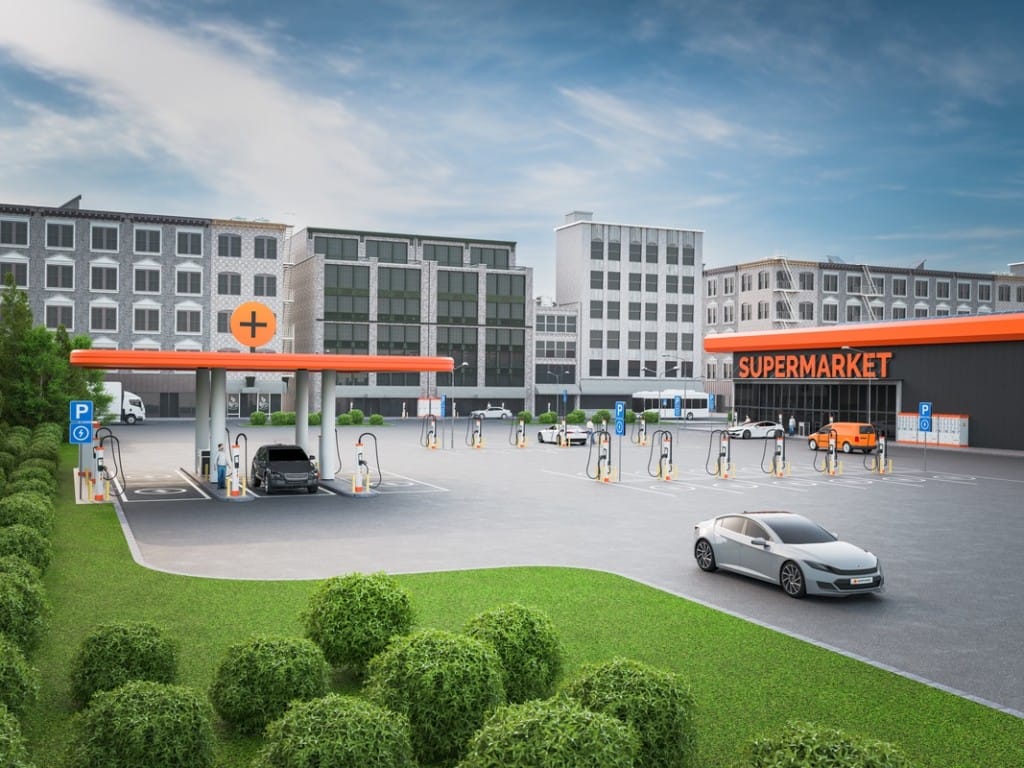A healthy EV market relies on two main factors: the prevalence of electric vehicles (EV) themselves, and the availability of charging infrastructure. Driven by tightening emissions regulations, the number of personal and commercial EVs on the road is already soaring in Europe and North America, with the total EV stock in Europe and North America expected to amount to 90 million by the year 2030.
With EV ownership growing, fast charging infrastructure needs to grow at a similar rate to serve these EVs and support emissions targets. A recent study by the European Automobile Manufacturers Association showed that up to 6.8 million public charging points would be required in Europe by 2030 to reach the proposed 55% CO2 reduction in road traffic.
In the face of accelerating EV ownership, availability of charging infrastructure is currently falling behind the rate of growth of EVs. A combination of government funding and innovative infrastructure from EV charging businesses is needed to boost charging infrastructure availability, to help it become an asset rather than a barrier to the EV revolution.
Building charging infrastructure for all geographies
The distribution of charging infrastructure between geographies is currently very uneven. For example, in the EU there are more than 330,000 publicly accessible charging points, yet 69% of these charging points are located in just three countries – Germany, France and the Netherlands. Meanwhile, 10 EU countries do not have a single charger per 100 km of road. For the EV evolution to truly be successful, access to charging points needs to be even, otherwise travel across Europe will become difficult, and EU climate targets will be hard to achieve.
There is also uneven distribution within countries. Whereas charging availability along busy routes connecting major cities is largely high, access to charging infrastructure in rural areas, and even within cities themselves, is lacking. A low number of EV drivers provides little financial incentive for businesses to invest in these areas, which has created a chicken and egg situation: businesses have no incentive to invest in charging points in places where little EV traffic passes, yet drivers aren’t encouraged to purchase EVs if no charging infrastructure is in place.
In these cases, the only way to break the standstill is government intervention. Government subsidies to incentivize businesses to invest in poorly-covered areas can encourage greater EV usage, and help kick-start the electric transition in struggling areas.
Though government funding is a useful way to advance the EV market in certain areas, it is not enough on its own – innovative charging technology built for the future also has an essential role. Many sites still adopt a traditional EV charging site set-up, offering only one or two plug-in points. While this is sufficient to serve a small number of EVs, it quickly becomes redundant as the market grows. At this stage of the EV evolution, modern charging stations built to grow with the market are needed. That’s where Kempower comes in.
More plugs and more power
At Kempower we have been studying EV drivers’ user experience and trends to help us create solutions for the future market for some time. Guided by market predictions, we build our solutions to overcome the potential barriers to a fast-growing EV market and to grow with the market as it inevitably changes.
Indeed, our research shows that as the EV market grows, charging availability will become increasingly threatened. That’s why we are aiming to offer more plugs and more power. This strategy involves increasing the number of plugs available at charging stations and boosting the power supplied by our chargers where necessary.
We see increasing the number of plugs available to drivers as paramount. A lot of EV drivers’ frustration when it comes to charging availability is related to queue times rather than charging times. By offering a larger number of plugs at a charging site, customers can be guaranteed the satisfaction of being able charge on arrival, vastly improving user experience.
We also ensure availability by offering dynamic charging. Our dynamic charging solution optimizes charging efficiencies when distributing charge to all EVs being charged at any one point. It can also charge at full volume whenever there’s enough grid capacity. This is an effective way of minimizing charging times, ensuring the best possible charging experience for drivers and an optimal revenue stream for charging point operators.

More powerful chargers are another useful way of cutting charging times and increasing availability. Whereas it’s a welcome luxury in the EV passenger car sector, more power is absolutely essential in the growing commercial vehicle market, because of vehicle size. We understand that for professional drivers, time is money, which is why we are focusing on cutting charging times as much as possible for commercial vehicles as part of our ‘more plugs and power’ strategy.
While building more powerful chargers is one way to do this, another method we use is a pre-booking system, which is enabled by our Kempower ChargEye solution. Allowing electric trucks to pre-book chargers eliminates the issues of queue anxiety for truck drivers, giving them extra reassurance that they will reach their destination on time.
Future-proof solutions for a growing market
At Kempower, we recognize that different geographies are at different stages of their EV market development. We also believe that all parts of the globe will embrace the EV transition in the near future. To cater to all needs and stages of the EV transition, we create modular and future-proof chargers.
The modularity of our chargers means they can always be expanded. Site owners can start small, to serve the market they currently have, and be reassured by the knowledge that they can grow their charging offering easily.
Moreover, we are constantly updating our chargers to make them up-to-date for the latest developments in the EV market. These updates can be installed in chargers already out in the field, meaning our customers don’t have to worry about buying new chargers. For example, last year we launched our adaptive voltage charging solution. The solution, which allows chargers to work with EV batteries up to 1000V, can be upgraded into existing chargers thanks to our modular technology.
By building future-proof solutions, we empower site owners to evolve their offerings at pace with the EV market, meaning they don’t have to worry about charging availability at their sites.
Looking forward to a bright a future for the EV revolution
Today, more and more European countries are reaching the crucial 10% threshold of all new cars bought being electric. It won’t be long until the U.S. reaches this point too, triggered by the $7.5 billion investment in basic charging infrastructure recently granted by the Biden administration. With such rapid growth on a global scale, it is important that charging infrastructure grows with the market, to prevent a lack of charging availability becoming a barrier to the imminent EV revolution.
I am confident that, with technological advancements being pioneered by businesses like Kempower and boosted by government support, EV charging infrastructure will continue to develop at a rate which supports our world’s growing EV market.

Written by
Tomi Ristimäki
CEO Kempower






